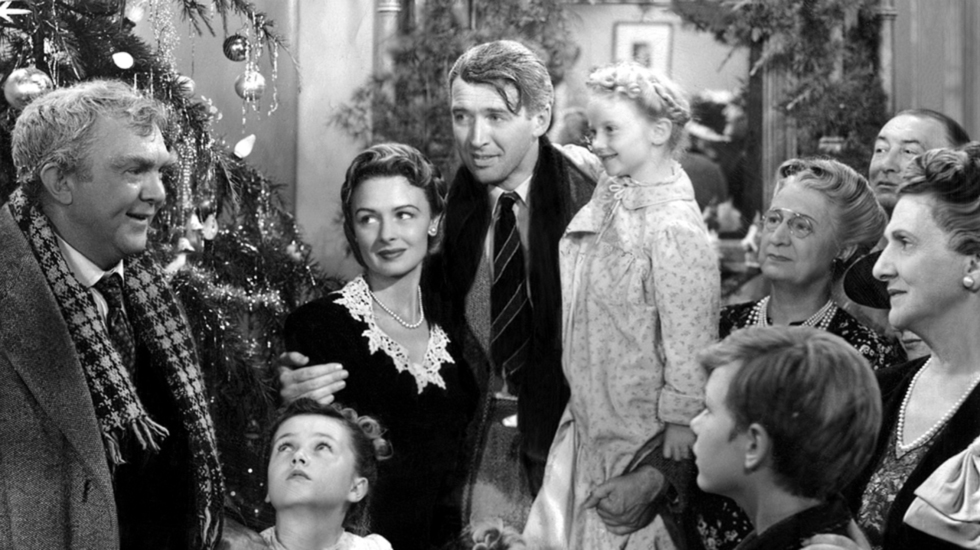
BY LIZ SPAULDING |
It's (Still) A Wonderful Life
Why does this holiday classic still reign supreme after 64 years? Find out this week on the big screen at IFC Center.

If you’ve ever heard someone do their “Jimmy Stewart impression,” you’ve likely heard a quote from his 1946 film (and, incidentally, Stewart's personal favorite from his filmography): It’s a Wonderful Life. Despite acting in numerous other quotable masterpieces, there hasn’t been a more iconic, more fitting role for Stewart than that of George Bailey. Frank Capra’s touching classic about a man at the end of his rope and his reevaluation of his life is consistently selected as one of the Top 20 greatest films of all time, with the American Film Institute naming it #1 on the 2006 list of Most Inspiring Films of All Time.
Why, after all these years, is It’s a Wonderful Life such a timeless classic, one that never fails to touch the hearts mist up the eyes of its audience?
Impeccable Casting
Jimmy Stewart perfectly embodies a self-sacrificing George Bailey, Donna Reed shines as Mary Hatch, and Lionel Barrymore is utterly despicable as the evil old curmudgeon Mr. Potter. It’s impossible to imagine this film without these lead actors, although in reality Stewart had to be convinced by Barrymore to take the role, it being his first film after the five-year hiatus he took to serve in World War II. Even today, Stewart remains the most highly ranked military officer who was also a Hollywood actor. Stewart, Reed and Barrymore’s performances and on-screen chemistry are part of what makes the film so special.
Simple-Yet-Endearing Secondary Characters
The ‘disreputable’ lady with a heart of gold, the arrogant-but-means-well unsuitable suitor, the forgetful and flighty uncle, the insightful and protective mother, the archetypal all-American kid brother… you name it, they’re in It’s a Wonderful Life. Though they’re not the driving forces behind the main story, they add a great amount of comedy, tenderness and endearment to the film, providing further impact to the alternate reality sequence where George views what life would be like if he had never been born.
Gorgeous Cinematography
Following the Hollywood style of the day, Capra throws in a well-placed freeze frame as well as an intense close-up on Jimmy Stewart, allowing him to perform an anxious stare right into the camera. The lighting and use of shadows in the film—particularly in the scenes with snow and during George’s visit to his abandoned derelict house at 320 Sycamore—are also stunningly executed. These little touches make the film visually memorable, and not just your standard Hollywood film.
The High School Graduation Scene
The gym floor opens up to a pool. Chaos ensues. Everyone takes a swim fully clothed. It’s a truly spectacular scene, and has been recreated in numerous music videos and other film projects ever since.
A Powerful Message
It’s a Wonderful Life tells the story of a bright and ambitious young man, George Bailey, who—given his duty, loyalty and morality—has not achieved the life he envisioned for himself. He never takes his trip to Europe, never goes to college, never takes his wife on their honeymoon, and never manages to leave Bedford Falls, the town that has nurtured and stifled him all his life.
Instead, he generously allows his family and friends to succeed, and manages the Bailey Building & Loan, which is so important to the people of Bedford Falls. Finally, when his Uncle Billy’s misplacement of $8,000 gives the evil Mr. Potter the ability to eliminate George Bailey and the Building and Loan, George contemplates killing himself. It’s only when his guardian angel Clarence Oddbody (impeccably played by Henry Travers) shows George how bleak the world would be without him that George realizes how significant and monumental his life has been, truly impacting the lives of everyone else around him.
The main lesson of the story is that life is far too precious to throw away. However, underneath is a much more subtle message: in an industry in which the epic, the grandeur, the most impressive stories are the stuff of movie-making, It’s a Wonderful Life dares to propose that maybe grand adventures are not necessarily the key to happiness, but rather that the little day-to-day moments amongst friends and family are what bring richness to life.
George could have grown up to build ten bridges, traveled to dozens of countries, perhaps without ever feeling that satisfaction and love he has found by staying in Bedford Falls. His marriage, his family, his ‘nickel & dime’ work at the Building and Loan, and the generosity he provides to the people of Bedford Falls are what enrich his life. When the entire town comes out in droves to help George during his time of need, it’s his decorated officer brother Harry who makes the observant toast: ‘To my brother George, the richest man in town.’ To the good people of Bedford Falls, it’s George who is the town hero.
It’s a Wonderful Life truly exemplifies the Great American Story: about redemption, appreciation of your life as you’ve lived it, and the significance each person plays in the lives of so many others. This is why it’s so difficult to manage a dry eye throughout the movie, and why the film is held in such high regard. No matter how technically sophisticated and 3D movies become in this new century, George Bailey and Bedford Falls are here to stay.